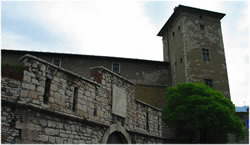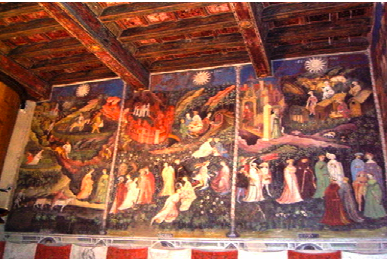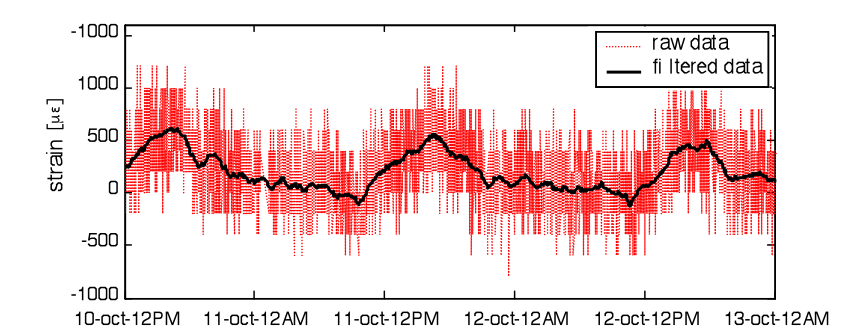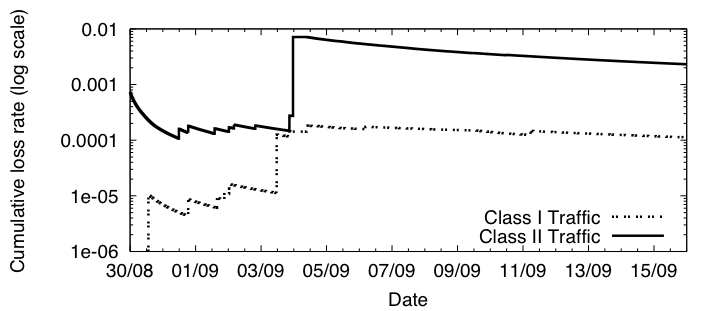

|
Torre Aquila is a 31 meters-tall tower located in Trento in the Buonconsiglio castle, one of the most important medieval historical sites in Italy. Inside the tower, thousands of visitors each year contemplate a group of 11 frescoes named "Ciclo dei Mesi" (cycle of the months). The artwork represents a unique example of non-religious medieval painting in Europe. In ancient times Torre Aquila represented the main entrance to the city from the East: with the expansion of the city in the second half of the 19th century, most of the eastern city wall was demolished and the entrance to the city was moved a few hundred meters south of the original gate. Today this solution is inadequate because of the increasing vehicular traffic. The solution to this problem, pursued by the Municipality of Trento, is to bypass the obstacle of the Castle compound with a road tunnel. The construction of the tunnel has been long delayed due to concerns by the conservation board that construction work might cause unwanted settlement of the tower foundations. The timely estimation of the potential risk to the frescoes requires real-time monitoring and appropriate response models to reproduce the structural behavior of the tower. |
In response to this need, D3S designed, developed, and deployed a structural monitoring system based on WSNs in Torre Aquila. The work has been carried out in collaboration with the Mechanical and Structural Engineering Department at the University of Trento and TRETEC S.r.l., in the context of a project funded by the Italian Ministry of Education (MIUR) under PRIN06 (more information available at the HHMS, Historical Heritage Monitoring System, web page). The pictures below illustrate the current deployment and the hardware employed. Our core hardware platform is the 3MATE!, an easily extendable Tmote-like device manufactured by TRETREC. We installed environmental sensors measuring temperature, humidity and light in different locations in the tower. Three tri-axial acceleration sensors record the tower vibrations at the bottom and topmost floors. The corresponding 3MATE! nodes are equipped with FRAM chips to cater for power-efficient, high-rate temporary storage. Additionally, Fiber Optic Sensors (FOS) are used to measure the vertical deformation of the tower and the sliding of two walls along a joint. The sensor network is wirelessly connected to the Internet through a Gumstix-based gateway.

Deployment setting.
 The software layers are designed and implemented using our TeenyLIME middleware. This approach yields a
highly decoupled software configuration that boosts efficiency and
code re-use. Using TeenyLIME, we developed an efficient data
collection protocol providing different guarantees for different types of traffic (e.g., strong reliability for vibration data as opposed to best effort for system information such as battery readings), a data dissemination mechanism, sampling and tasking functionality, a time synchronization scheme, and a customized compression library. Users interact with the system remotely using a graphical user interface, whereby they can task the system according to application requirements and visualize the data gathered.
The software layers are designed and implemented using our TeenyLIME middleware. This approach yields a
highly decoupled software configuration that boosts efficiency and
code re-use. Using TeenyLIME, we developed an efficient data
collection protocol providing different guarantees for different types of traffic (e.g., strong reliability for vibration data as opposed to best effort for system information such as battery readings), a data dissemination mechanism, sampling and tasking functionality, a time synchronization scheme, and a customized compression library. Users interact with the system remotely using a graphical user interface, whereby they can task the system according to application requirements and visualize the data gathered.
 The deployment provided valuable data to structural
engineers to assess the conditions of Torre Aquila. For instance, the
picture on the right reports the strain measured by the fiber optic sensor 154 placed across the joint. The graph illustrates the "breath" of the
structure, due to the daily thermal variations. The joint is forced to open due to thermal expansion when sun rays hit the southern facade, and then it closes during the night. The analysis of such a behavior allows the structural engineers to assess the sensitivity of the joint to temperature.
The deployment provided valuable data to structural
engineers to assess the conditions of Torre Aquila. For instance, the
picture on the right reports the strain measured by the fiber optic sensor 154 placed across the joint. The graph illustrates the "breath" of the
structure, due to the daily thermal variations. The joint is forced to open due to thermal expansion when sun rays hit the southern facade, and then it closes during the night. The analysis of such a behavior allows the structural engineers to assess the sensitivity of the joint to temperature.
 The system was deployed in August 2008 and had been operational for about 2 years. So far, the overall data loss rate
always remained below 0.01%, a striking performance compared
to long-running WSN deployments in the
current literature. As an example, the picture on the right shows the loss rate (in log scale) for high-rate vibration data (class I traffic) and temperature readings (class II traffic). In the morning of September 3rd a malfunctioning node caused the spike relative to class I traffic. Later on the same day we replaced the faulty node and performed a few maintenance operations. This caused the spike in class II traffic. Afterwards, the loss rate decreased steadily.
The system was deployed in August 2008 and had been operational for about 2 years. So far, the overall data loss rate
always remained below 0.01%, a striking performance compared
to long-running WSN deployments in the
current literature. As an example, the picture on the right shows the loss rate (in log scale) for high-rate vibration data (class I traffic) and temperature readings (class II traffic). In the morning of September 3rd a malfunctioning node caused the spike relative to class I traffic. Later on the same day we replaced the faulty node and performed a few maintenance operations. This caused the spike in class II traffic. Afterwards, the loss rate decreased steadily.
More information on the Torre Aquila deployment and the software used can be found in:
- M. Ceriotti, L. Mottola, G. P. Picco, A. L. Murphy, Ş. Gună, M. Corrà, M. Pozzi, D. Zonta, and P. Zanon. "Monitoring Heritage Building with Wireless Sensor Networks: the Torre Aquila Deployment". In Proc. of the 8th Int. Conf. on Information Processing in Sensor Networks (IPSN) - SPOTS track, 2009. Best Paper Award.
- P. Costa, L. Mottola, A. L. Muprhy, and G. P. Picco. "Programming Wireless Sensor Networks with the TeenyLIME Middleware". In Proc. of ACM/IFIP/USENIX Middleware, 2007.











